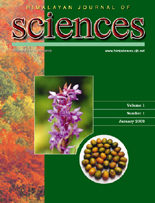On the distribution and status of Tibetan argali, <i>Ovis ammon hodgsoni</i> Blyth, 1841 in Nepal
DOI:
https://doi.org/10.3126/hjs.v1i1.184Keywords:
Ovis ammon Hodgsoni, Tibetan argali, NepalAbstract
A team of biologists observed 24 argalis in 4 herds in a biodiversity survey of the upper Mustang region in Chhojung and Damodarkund areas. The Tibetan argalis utilize smooth slopes with low bushes and herbage at lower elevation and the alpine meadows at higher elevation in the Chhojung region. In the upper Damodarkund area at >5200m, the argali occupy the Tibetan desert steppe characterized by desolate plains and low undulating sand hills. In this desert terrain, very little food is available mostly in the form of xerophytic herbs. Anthropogenic activities have negative impacts on the argalis and their habitats. Therefore, in-situ conservation of this Trans-Himalayan species is urgent. Himalayan Journal of Sciences 1(1): 37-41, 2003Downloads
Download data is not yet available.
Abstract
947
PDF
927
Downloads
How to Cite
Shah, K. B. (2006). On the distribution and status of Tibetan argali, <i>Ovis ammon hodgsoni</i> Blyth, 1841 in Nepal. Himalayan Journal of Sciences, 1(1), 37–41. https://doi.org/10.3126/hjs.v1i1.184
Issue
Section
Research Papers




